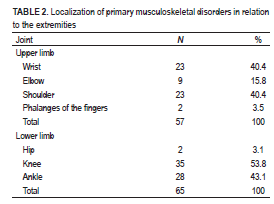The effect of the application of Kinesio Tape on pain relief in musculoskeletal disorders
DOI:
https://doi.org/10.17532/jhsci.2023.2176Keywords:
Kinesis tape, musculoskeletal disorders, painAbstract
Introduction: Musculoskeletal disorders (MSDs) are common in men and women of all ages in all sociodemographic strata of society. Pain and functional limitations caused by MSDs severely limit independence and quality of life and interfere with an individual’s ability to participate in family and social life and work. The aim of this study is to investigate the effects of the Kinesio Tape (KT) technique on pain intensity in patients with MSDs of the upper and/or lower extremities before, during, and after therapeutic treatment.
Methods: The study involved 123 patients of both sexes and all ages diagnosed with MSDs of the upper and/or lower extremities. Patients were randomly divided into two groups, a control group and an experimental group. The control group received the standard therapy protocol for MSDs, while the experimental group received the standard therapy protocol for MSDs plus the KT technique on the treated segment. The brief pain inventory was used to assess pain intensity. Both groups of participants were tested with the research instruments at baseline, during and after therapeutic treatment.
Results: The ability to walk due to pain was significantly less impaired in the control group than in participants in the experimental group, in whom pain significantly impeded walking (p < 0.001). Normal walking was significantly more impaired in the experimental group than in the control group (p = 0.001). Pain significantly impaired relationships with others in the experimental group compared to the control group (p < 0.001).
Conclusion: Subjects in the experimental group showed a significant decrease in pain in all areas after therapeutic treatment with KT compared to subjects in the control group.
Downloads

Downloads
Published
License
Copyright (c) 2023 Dinko Remić, Samir Bojičić, Amra Mačak Hadžiomerović, Amila Jaganjac, Eldad Kaljić, Dženan Pleho, Bakir Katana

This work is licensed under a Creative Commons Attribution 4.0 International License.










